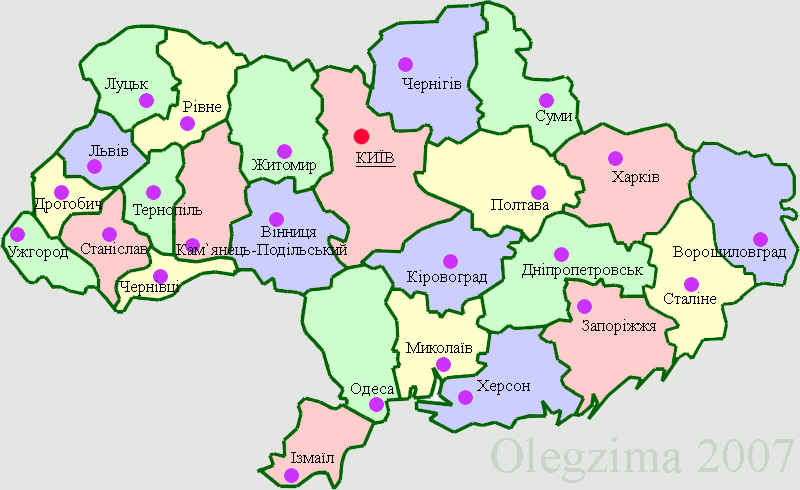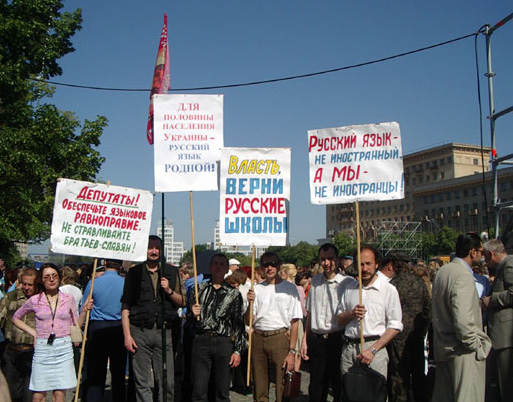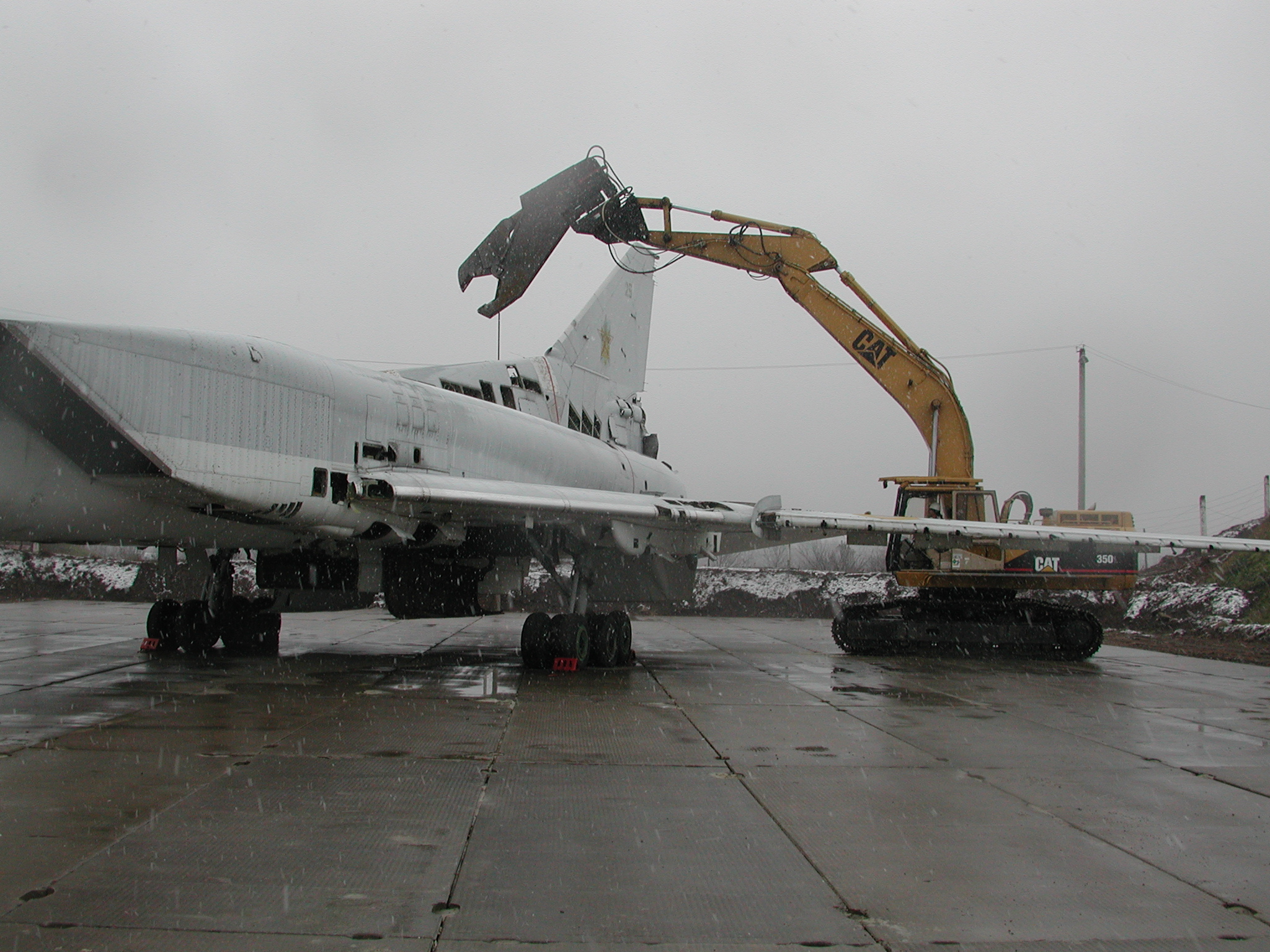|
Pravdyne
Pravdyne ( uk, Правдине, previously known as Tsarevodar) is a village (selo) of Ukraine in the Bilozerka settlement hromada, Kherson Raion, Kherson Oblast. In 2001, it had a population of 1,621. History Founding and early history Originally known as Tsarevodar, the village was founded in 1846 by immigrants from the western provinces of the Russian Empire, namely those of Vilna Governorate, Vilna, Grodno Governorate, Grodno, and Podolia Governorate, Podolia. The original name of Tsarevodar reflects the fact that the land for the village came from the state's fund, and hence the Tsar's. As of 1886, 1,368 people lived in the village, which contained a prayer house, a school, and two shops. 2022 Russian invasion of Ukraine The city was occupied by the Russian armed forces following the Battle of Kherson in early 2022. During the 2022 Ukrainian southern counteroffensive, the Armed Forces of Ukraine liberated the town. Demographics According to the Soviet Census (1989) ... [...More Info...] [...Related Items...] OR: [Wikipedia] [Google] [Baidu] |
2022 Ukrainian Southern Counteroffensive
A military counteroffensive was launched by Ukraine on 29 August 2022 to expel Russian forces occupying the southern regions of Kherson and Mykolaiv oblasts. Military analysts consider the counteroffensive to be the third strategic phase of the war in Ukraine, along with the concurrent eastern counteroffensive, after the initial invasion and the Battle of Donbas. After many strikes against Russian military targets, Ukraine announced the start of a full-scale counteroffensive on 29 August 2022. On 9 October, Ukraine said it recaptured 1,170 square kilometers of land. On 9 November, Russian troops were ordered to withdraw from Kherson, the only regional capital captured since the start of the invasion. Ukrainian forces recaptured the city of Kherson two days later, on 11 November. Background Russian offensive During the 2022 Southern Ukraine offensive, Russian troops invaded the Kherson, Zaporizhzhia, and Mykolaiv Oblasts. In the early days of the war, Russian tro ... [...More Info...] [...Related Items...] OR: [Wikipedia] [Google] [Baidu] |
Oblasts Of Ukraine
An oblast ( uk, о́бласть; ) in Ukraine, often called a region or province, is the main type of first-level administrative division of the country. Ukraine's territory is divided into 24 oblasts, as well as one autonomous republic, Crimea, and two cities with special status, Kyiv and Sevastopol. Ukraine is a unitary state, thus the oblasts do not have much legal scope of competence other than that which is established in the Ukrainian Constitution and by law. Articles 140–146 of Chapter XI of the constitution deal directly with local authorities and their competency. Oblasts are subdivided into raions (districts), each oblast having from 3 to 10 raions following the July 2020 reform. General characteristics In Ukraine, the term '' oblast'' denotes a primary administrative division. Under the Russian Empire and into the 1920s, Ukraine was divided between several governorates. The term ''oblast'' was introduced in 1932 by Soviet authorities when the Ukrainian SSR ... [...More Info...] [...Related Items...] OR: [Wikipedia] [Google] [Baidu] |
Commons Category Link Is On Wikidata
The commons is the cultural and natural resources accessible to all members of a society, including natural materials such as air, water, and a habitable Earth. These resources are held in common even when owned privately or publicly. Commons can also be understood as natural resources that groups of people (communities, user groups) manage for individual and collective benefit. Characteristically, this involves a variety of informal norms and values (social practice) employed for a governance mechanism. Commons can also be defined as a social practice of governing a resource not by state or market but by a community of users that self-governs the resource through institutions that it creates. Definition and modern use The Digital Library of the Commons defines "commons" as "a general term for shared resources in which each stakeholder has an equal interest". The term "commons" derives from the traditional English legal term for common land, which are also known as "commons", ... [...More Info...] [...Related Items...] OR: [Wikipedia] [Google] [Baidu] |
Villages In Kherson Raion
A village is a clustered human settlement or community, larger than a hamlet but smaller than a town (although the word is often used to describe both hamlets and smaller towns), with a population typically ranging from a few hundred to a few thousand. Though villages are often located in rural areas, the term urban village is also applied to certain urban neighborhoods. Villages are normally permanent, with fixed dwellings; however, transient villages can occur. Further, the dwellings of a village are fairly close to one another, not scattered broadly over the landscape, as a dispersed settlement. In the past, villages were a usual form of community for societies that practice subsistence agriculture, and also for some non-agricultural societies. In Great Britain, a hamlet earned the right to be called a village when it built a church. [...More Info...] [...Related Items...] OR: [Wikipedia] [Google] [Baidu] |
Belarusian Language In Ukraine
According to the Ukrainian census of 2001, the Belarusian language is native to 56,249 people in the country, including 19.8% of ethnic Belarusians. The largest number of Belarusian-speakers live in Dnipropetrovsk Oblast (6,239), Crimea (5,204) and Donetsk Oblast (4,842). The regions with the largest percentages of Belarusian speakers out of their total population are Crimea (0.26%), Chernihiv Oblast Chernihiv Oblast ( uk, Черні́гівська о́бласть, translit=Chernihivska oblast; also referred to as Chernihivshchyna, uk, Черні́гівщина, translit=Chernihivshchyna) is an oblast (province) of northern Ukraine. T ... (0.19%) and Dnipropetrovsk Oblast (0.18%). Overall In Ukraine overall, Belarusian speakers over time: Among ethnic Belarusians According to censuses, the native languages of ethnic Belarusians in Ukraine were: Among Belarusians of Ukraine, their fluency in the Belarusian language dropped from 48.5% to 31.7% from 1989 to 2001. ... [...More Info...] [...Related Items...] OR: [Wikipedia] [Google] [Baidu] |
Romanian Language
Romanian (obsolete spellings: Rumanian or Roumanian; autonym: ''limba română'' , or ''românește'', ) is the official and main language of Romania and the Republic of Moldova. As a minority language it is spoken by stable communities in the countries surrounding Romania (Bulgaria, Hungary, Serbia, and Ukraine), and by the large Romanian diaspora. In total, it is spoken by 28–29 million people as an L1+ L2, of whom 23–24 millions are native speakers. In Europe, Romanian is rated as a medium level language, occupying the tenth position among thirty-seven official languages. Romanian is part of the Eastern Romance sub-branch of Romance languages, a linguistic group that evolved from several dialects of Vulgar Latin which separated from the Western Romance languages in the course of the period from the 5th to the 8th centuries. To distinguish it within the Eastern Romance languages, in comparative linguistics it is called ''Daco-Romanian'' as opposed to its closest r ... [...More Info...] [...Related Items...] OR: [Wikipedia] [Google] [Baidu] |
Moldovan Language
Moldovan (Latin alphabet: ''limba moldovenească''; Moldovan Cyrillic alphabet: лимба молдовеняскэ), also known historically as Moldavian, is one of the two local names of the Romanian language in Moldova. "Moldovan" is declared the official language in Article 13 of the constitution adopted in 1994, while the 1991 Declaration of Independence of Moldova uses the name "Romanian". In 2003, the Moldovan parliament adopted a law defining "Moldovan" and "Romanian" as glottonyms for the same language. In 2013, the Constitutional Court of Moldova interpreted that Article 13 of the constitution is superseded by the Declaration of Independence, thus giving official status to the name "Romanian". The breakaway region of Transnistria continues to recognize "Moldovan" as one of its official languages, alongside Russian and Ukrainian. Ukraine also makes a distinction between "Moldovan" and Romanian in its law, though Ukrainian officials have announced an intention ... [...More Info...] [...Related Items...] OR: [Wikipedia] [Google] [Baidu] |
Russian Language In Ukraine
Russian is the most common first language in the Donbas and Crimea regions of Ukraine and the city of Kharkiv, and the predominant language in large cities in the eastern and southern portions of the country. The usage and status of the language is the subject of political disputes. Ukrainian is the country's only state language since the adoption of the 1996 Constitution, which prohibits an official bilingual system at state level but also guarantees the free development, use and protection of Russian and other languages of national minorities. In 2017 a new ''Law on Education'' was passed which restricted the use of Russian as a language of instruction. Nevertheless, Russian remains a widely used language in Ukraine in pop culture and in informal and business communication. History of Russian language in Ukraine The East Slavic languages originated in the language spoken in Rus in the medieval period. Significant differences in spoken language in different regions b ... [...More Info...] [...Related Items...] OR: [Wikipedia] [Google] [Baidu] |
Ukrainian Language
Ukrainian ( uk, украї́нська мо́ва, translit=ukrainska mova, label=native name, ) is an East Slavic language of the Indo-European language family. It is the native language of about 40 million people and the official state language of Ukraine in Eastern Europe. Written Ukrainian uses the Ukrainian alphabet, a variant of the Cyrillic script. The standard Ukrainian language is regulated by the National Academy of Sciences of Ukraine (NANU; particularly by its Institute for the Ukrainian Language), the Ukrainian language-information fund, and Potebnia Institute of Linguistics. Comparisons are often drawn to Russian, a prominent Slavic language, but there is more mutual intelligibility with Belarusian,Alexander M. Schenker. 1993. "Proto-Slavonic," ''The Slavonic Languages''. (Routledge). pp. 60–121. p. 60: " hedistinction between dialect and language being blurred, there can be no unanimity on this issue in all instances..."C.F. Voegelin and F.M. Voegelin ... [...More Info...] [...Related Items...] OR: [Wikipedia] [Google] [Baidu] |
Ukrainian Census (2001)
The Ukrainian Census of 2001 is to date the only census of the population of independent Ukraine. It was conducted by the State Statistics Committee of Ukraine on 5 December 2001, twelve years after the last Soviet Union census in 1989.In 2021, there will most likely be no all-Ukrainian census - Minister hromadske.ua (21 April 2020) The next Ukrainian census was planned to be held in 2011 but has been repeatedly postponed [...More Info...] [...Related Items...] OR: [Wikipedia] [Google] [Baidu] |
Soviet Census (1989)
The 1989 Soviet census (russian: Всесоюзная перепись населения 1989, lit=1989 All-Union Census), conducted between 12 and 19 January of that year, was the last one that took place in the Soviet Union. The census found the total population to be 286,730,819 inhabitants. In 1989, the Soviet Union ranked as the third most populous in the world, above the United States (with 248,709,873 inhabitants according to the 1990 census), although it was well below China and India. Statistics In 1989, about half of the Soviet Union's total population lived in the Russian SFSR, and approximately one-sixth (18%) of them in the Ukrainian SSR. Almost two-thirds (65.7%) of the population was urban, leaving the rural population with 34.3%.Encyclopædia Britannica Book of the Year 1991, Soviet Union, page 720. In this way, its gradual increase continued, as shown by the series represented by 47.9%, 56.3% and 62.3% of 1959, 1970 and 1979, respectively. [...More Info...] [...Related Items...] OR: [Wikipedia] [Google] [Baidu] |
Armed Forces Of Ukraine
, imports = , exports = , history = , ranks = Military ranks of Ukraine , country=Ukraine The Armed Forces of Ukraine ( uk, Збро́йні си́ли Украї́ни), most commonly known in Ukraine as ZSU ( uk, ЗСУ) or anglicized as AFU, are the military forces of Ukraine. All military and security forces, including the Armed Forces, are under the command of the president of Ukraine and subject to oversight by a permanent Verkhovna Rada parliamentary commission. The modern armed forces were formed in 1991 and consisted of three former Soviet Armed Forces military districts stationed in the Ukrainian Soviet Socialist Republic. Ukraine's armed forces are composed of the Ukrainian Ground Forces, the Ukrainian Air Force, the Ukrainian Navy, the Ukrainian Air Assault Forces and the Special Operations Forces. Ukraine's navy includes its own Ukrainian Naval Infantry, as well as Ukrainian Naval Aviation. The Territori ... [...More Info...] [...Related Items...] OR: [Wikipedia] [Google] [Baidu] |









